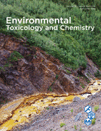Mixture toxicity of nickel and zinc to Daphnia magna is non-interactive at low effect sizes, but becomes synergistic at high effect sizes
 Until now, risk assessment of metals is generally based on data obtained from toxicity tests with individual metals, although in the environment metals mostly occur as mixtures. To be able to incorporate metal mixture toxicity in risk assessment frameworks, more data on the effects of metal mixtures on aquatic organisms during chronic exposure is necessary. Therefore, we investigated the effects of a binary Ni-Zn mixture on chronic reproductive toxicity to the water flea Daphnia magna during two independent large-scale experiments. The results suggested that the type of interactive effect is dependent on the effect size at which Ni and Zn are combined in the mixture. Weak antagonistic or non-interactive effects occurred in the mixture treatments where each of the individual metals produced insignificant or only weak adverse effects on their own (i.e. less than 20% reduction of reproductive performance). Conversely, synergistic mixture effects, i.e., stronger effects than expected, only occurred when at least one of both metals in the mixture caused a greater than 20% effect on reproduction. Since low effect sizes are the most relevant ones in most regulatory frameworks, our data suggest that the CA and IA mixture toxicity models can both serve as conservative models for predicting effects of Ni-Zn mixtures.
Until now, risk assessment of metals is generally based on data obtained from toxicity tests with individual metals, although in the environment metals mostly occur as mixtures. To be able to incorporate metal mixture toxicity in risk assessment frameworks, more data on the effects of metal mixtures on aquatic organisms during chronic exposure is necessary. Therefore, we investigated the effects of a binary Ni-Zn mixture on chronic reproductive toxicity to the water flea Daphnia magna during two independent large-scale experiments. The results suggested that the type of interactive effect is dependent on the effect size at which Ni and Zn are combined in the mixture. Weak antagonistic or non-interactive effects occurred in the mixture treatments where each of the individual metals produced insignificant or only weak adverse effects on their own (i.e. less than 20% reduction of reproductive performance). Conversely, synergistic mixture effects, i.e., stronger effects than expected, only occurred when at least one of both metals in the mixture caused a greater than 20% effect on reproduction. Since low effect sizes are the most relevant ones in most regulatory frameworks, our data suggest that the CA and IA mixture toxicity models can both serve as conservative models for predicting effects of Ni-Zn mixtures.
Scientific abstract
To incorporate metal mixture toxicity effects into risk-assessment procedures, more information is needed about combined and interactive effects of metal mixtures during chronic exposure. The authors investigated the toxicity of binary Ni–Zn mixtures in 2 independent full-factorial experiments using standard chronic (21-d) Daphnia magna reproduction toxicity tests. Global statistical analysis (i.e., when considering all investigated mixture treatments simultaneously) showed noninteractive effects according to the concentration addition model and significant synergistic effects according to the independent action model. However, treatment-specific statistical analysis revealed that both occurrence and type of interactive effect were dependent on the effect size at which Ni and Zn were combined in the mixture. Only noninteractive or weakly antagonistic effects occurred in mixture treatments in which each of the individual metals produced only weak adverse effects on its own (i.e., ≤20% reduction of reproductive performance). On the other side of the spectrum, synergistic mixture effects occurred in all mixture treatments where both metals already caused a > 20% (for independent action) and a > 40% (for concentration addition) effect on reproduction on their own. Because low effect sizes are the most relevant in most regulatory frameworks, the authors' data suggest that the concentration addition and independent action mixture toxicity models can both serve as conservative models for predicting effects of Ni–Zn mixtures. The present study highlights the importance of investigating metal mixture toxicity at low effect sizes and warns against extrapolating conclusions about metal mixture interactions from high to low effect sizes.
Full reference (link)
Nys C, Asselman J, Hochmuth JD, Janssen CR, Blust R, Smolders E, De Schamphelaere KAC. 2015. Mixture toxicity of nickel and zinc to Daphnia magna is non-interactive at low effect sizes, but becomes synergistic at high effect sizes. Environmental Toxicology and Chemistry, accepted article.
